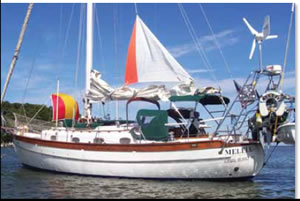
Photos by David Liscio and Frank Lanier
300
In any wind, our Jenneau 39i charges around an anchorage like a scalded cat, fetching up at the end of each tack (bow more than 90 degrees from the direction of the rode) with a noticeable jerk—even with a scope of more than 5:1. Comparing the behavior of other, more traditional boats in the same anchorage suggests that our centroid of windage is well forward, and that the cutaway foot and high-aspect keel offer limited resistance to the turn.
An all-chain rode and the addition of a full cockpit enclosure have helped dampen the motion a bit. After several experiments, we were able to get her to lie quietly to anchor on a bridle attached to the chain. Each leg of the bridle was about 25 to 30 feet, one cleated off forward and one amidships.
The next challenge is how best to attach the bridle to the chain. In the test, we simply tied each bridle leg to the chain using a rolling hitch. A number of makers offer chain claws or grabs. Have you looked at this type of equipment?
Jonathan Seymour
Norna J, Jenneau 39i
Gibsons, British Columbia
A bridle can be a workable solution to the anchor dance, but we don’t recommend it for a few reasons. It can be challenging to cast off a tied-on or hooked-on bridle when it’s under load and there’s an emergency in high winds. Also, bridling puts the boat more beam-on to the wind, which can be troublesome in heavier winds. More surface area equates to more load on the ground tackle.
Our preferred solutions would be (in order of preference): adding an all-chain rode (as you’ve already tried); adding a 30- to 35-pound kellet to your anchor rode; setting two anchors off the bow in a 45-degree Y-shaped pattern; or rigging a riding sail.
A kellet, which is more typically used on rope-chain rodes, will steepen the initial drop of the rode and flatten it out on the sea bottom. For better holding, a kellet should be attached at the midway point of the scope, but to take the pounding out of surges, place it a little bit higher on the rode, closer to the boat. Take a look at PS’s December 2003 kellet evaluation.
A riding sail can also help ease the jerking, but some add annoying rig sounds and are hard to attach to a backstay with antenna insulators installed. We tried out two, the Banner Bay FinDelta and the Sailrite kit, and reported on them in the December 2007 issue. Testers spent more time with the FinDelta, which performed as advertised and caused no added rigging noise.
If you decide to continue using a bridle setup, we’d recommend using a chain hook over a knot; they are easier to set than tied knots, and more importantly, they can be gotten rid of more easily and quickly in a dragging scenario. The plain old galvanized chain hooks are fine.
If you prefer using a knot, however, then try one of the top gripping hitches for loaded lines (PS, August 2009). For connecting the bridle to a chain rode, we’d use a rolling hitch or an icicle hitch. There are instructions on how to tie both at www.animatedknots.com.


































